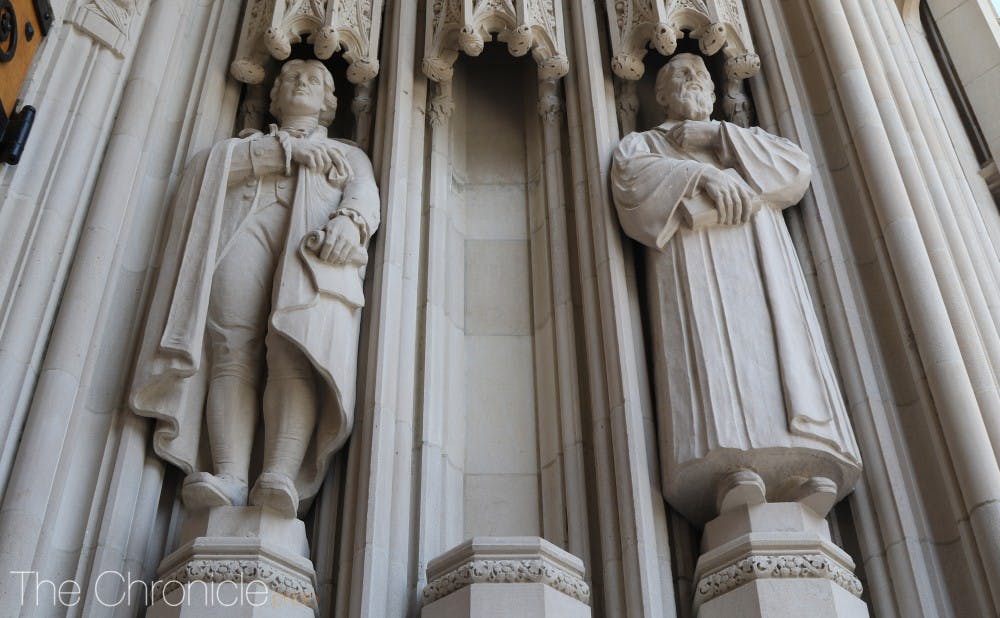In 2017, President Vince Price made a bold decision. At the height of protests against monuments commemorating the Confederacy, anonymous protesters damaged the sculptural portrayal of Confederate General Robert E. Lee on the exterior of Duke Chapel. Without delay, Price had the statue taken down and promised a debate. The happy result: tensions did not escalate, and Duke demonstrated an institutional awareness of its historical baggage. (Compare that to UNC down the road, where protests against Silent Sam, the Confederate statue on campus, led to no resolution. Monday, the day before classes started, protesters took it down overnight, in a widely reported scene.) Three weeks after Duke’s statue was removed, Price set up a commission which began a long debate on what to do with the newly empty space. In 2018, President Price made a decision that was less brave, unfortunately. In an email last week he decided to follow a recommendation the commission made last December: to leave the space empty. The commission had recommended doing this for a year. President Price now apparently wants the space to remain empty indefinitely. The justification, borrowed from the Dean of the Chapel, is that the empty space may be seen to represent “a hole that is in the heart of the United States of America, and perhaps in our own human hearts—that hole that is from the sin of racism and hatred of any kind.” A plaque will explain this.
That is certainly heartfelt. But it is also, ultimately, nearly as empty as the space itself. “The sin of racism and hatred of any kind” is generic. It turns into an abstraction what is a very concrete experience in the South, in Durham, at Duke University. Our sin is not racism and hatred “of any kind,” it is a specific history of slavery, racial segregation, the erasure of African-American innovators (like Julian Abele, the architect), and later, of gentrification of historically black neighborhoods and anti-black violence.
What is worse, the empty space further reinforces the very problem it is supposed to address, namely the absence of African-Americans in our celebrations of Southern history. Price calls the empty space “a powerful statement about the past, the present and our values.” But what exactly is this statement, and what are these values? There used to be six white men on the outside of the Chapel. Now there are five and an empty space—an invisible man, to invoke Ellison’s novel. We commemorate the absence of African-Americans by perpetuating that absence. We deplore that African-Americans have been invisible in the past, and we continue their invisibility into the future. There are plans to compensate for this by commemorating elsewhere on Campus the laborers involved in building Duke and the first African American student, as well as some sort of exhibit to show the history of different buildings and emblems on Duke’s campus—a promising start, but also a kind of renewed segregation.
None of this would be necessary. The commission had also recommended an alternative (and, one might add, much more intuitive) option for the empty space, namely a statue of a different individual—Martin Luther King or Pauli Murray. Among the two, Pauli Murray seems the more obvious choice, given that she more strongly than Dr. King represents the locality. The Commission seems to have shared the sentiment, suggesting that if the empty space was to be filled with a new individual, it should address the lack of commemoration for women and people of color in Duke Chapel.
Yale University has named a residential college after this Durhamite civil rights activist and Episcopalian priest. The space outside the Chapel seems the most obvious place for Duke to follow suit.
Maybe there is still time for this?
In 2018, Murray was made a permanent part of the Episcopal Church’s calendar of saints, commemorated July 2nd. July 2nd, 2019 might be a good date to announce that the space has been empty long enough and will now be filled again. Filling the void, making our home saint visible as a representative of that other part of our history, would be a good step in Duke’s efforts, so admirably led by President Price so far, to confront and move beyond the problematic parts of our legacy.
Ralf Michaels is the Arthur Larson professor at Duke Law School.
Get The Chronicle straight to your inbox
Signup for our weekly newsletter. Cancel at any time.

